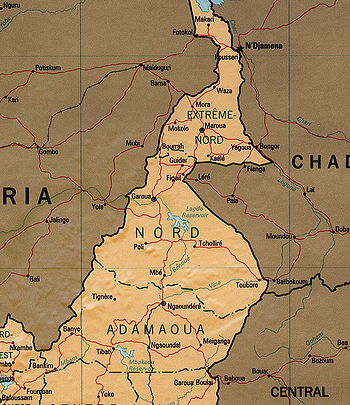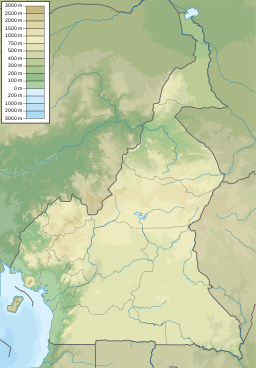Lagdo Reservoir
| Lagdo Reservoir | |
|---|---|
 Lagdo Reservoir in 2007 | |
| Location | North Province |
| Coordinates | 8°53′N 13°58′E / 8.883°N 13.967°E |
| Type | reservoir |
| Primary inflows | Benue River |
| Primary outflows | Benue River |
| Basin countries | Cameroon |
| Built | 1977–1982 |
| Surface area | 586 km2 (226 sq mi) |

Lagdo Reservoir is a reservoir located in the Northern Province of Cameroon, on the Benue River, in the Niger basin. The lake covers an area of 586 km2.
History
The Lagdo dam was built between August 1977 and July 1982 by a combination of engineers and Chinese workers, along with Cameroonian labourers.[1] The company that managed the construction was the China International Water & Electric Corp. International power company AES Corporation runs the hydroelectric dam.[2]
Its construction was intended to supply electricity to the northern part of the country and allow the irrigation of 15,000 hectares of crops downstream.[3] The dam is 308 m long, 40 m in height and 9 m thick.
Its reservoir has a potential of 7.7 billion cubic meters.[1] However, due to its aging and the silting up of its reservoir, its capacity has deteriorated over time reaching 1.6 billion m3 in 2021.[4]
Location
The dam is located 50 km south of the city of Garoua on the Benue River. The dam is located within the Arrondissement de Lagdo in the Département de la Benoué in the North Province.[5] It is situated more exactly at 8°53′N 13°58′E / 8.883°N 13.967°E.
Floods

In 2012, water released from the dam flooded areas including Adamawa State in Nigeria, resulting in more than 10 deaths and the loss of properties worth thousands of dollars. A bigger effect of the flooding was at the lower Benue river region where more than 10,000 homes were submerged for more than two weeks. This left more than 10,000 hectares of farmland flooded and the streets of Makurdi occupied by crocodiles and other dangerous creeping creatures.[6]
In September 2022, an operation to release a portion of water from the Lagdo Dam began to secure its installations.[7] Consequently, Nigerian authorities have indicated that the discharge of water from Lagdo caused farmland to be submerged and heavy flooding in 13 states,[8] thus causing the death of 25 people in Adamawa State for instance.[9] However, the Nigerian Minister of Water Resources, Suleiman Adamu Kazaure, stated that 80% of the floods in Nigeria are caused by rainfall and not the Lagdo Reservoir, and confirmed that the cause of the flood was due to water flowing from the tributaries of Katsina Ala River and others into Benue River due to heavy downpour.[10][11]
The absence of dams to contain water released from the Lagdo Dam at any point in time has been identified as a major cause for flooding in Nigeria.[12]
References
- ^ a b Ngounou Ngatcha, Benjamin; Njitchoua, Roger; Naah, Emmanuel (17 January 2017), Arfi, Robert; Kuper, Marcel; Morand, Pierre; Orange, Didier (eds.), "Le barrage de Lagdo (Nord-Cameroun) : Impact sur les plaines d'inondation de la Bénoué", Gestion intégrée des ressources naturelles en zones inondables tropicales, Colloques et séminaires (in French), Marseille: IRD Éditions, pp. 455–474, doi:10.4000/books.irdeditions.8583, ISBN 978-2-7099-1817-6, retrieved 22 March 2023
- ^ adefaye (2 July 2013). "Cameroon, the River Benue and Nigeria". Vanguard News. Retrieved 30 October 2022.
- ^ Imokhai-Bello, Ishioma (21 October 2022). "Lagdo Dam: How Nigerians are paying for the irresponsibilities of past governments". Ventures Africa. Retrieved 22 March 2023.
- ^ Ecofin, Agence (17 December 2021). "Cameroun : le barrage de Lagdo perd 3 milliards m3 d'eau en deux ans (gouvernement)". Agence Ecofin (in French). Retrieved 22 March 2023.
- ^ Omorogbe, Paul (10 October 2022). "Nigeria's perennial flooding and effect of Cameroon's Lagdo Dam". Tribune Online. Retrieved 30 October 2022.
- ^ "Disaster: Warning about impending flood". Blueprint Newspapers Limited. 23 May 2018. Retrieved 30 October 2022.
- ^ M, Rachel (14 September 2022). "Barrage de Lagdo : Eneo va relâcher une partie des eaux". ÔCamer.com (in French). Retrieved 22 March 2023.
- ^ "NEMA: 13 states to record heavy flooding as Cameroon opens Lagdo dam". TheCable. 20 September 2022. Retrieved 22 March 2023.
- ^ "Flood kills 25, displaces 130,200 in Adamawa, Plateau". Punch Newspapers. 21 September 2022. Retrieved 30 October 2022.
- ^ "80% of floods caused by rainfall NOT Lagdo dam, says minister". TheCable. 20 October 2022. Retrieved 22 March 2023.
- ^ Nliam, Amaka (21 October 2022). ""Cameroon's Dam not responsible for Floods," says Nigerian Government". Voice of Nigeria. Retrieved 22 March 2023.
- ^ "Quick facts about Cameroon's Lagdo Dam causing floods in Nigeria". The Nation. 18 October 2022.
- CS1 French-language sources (fr)
- Use dmy dates from November 2013
- Articles with short description
- Short description is different from Wikidata
- Pages using infobox body of water with auto short description
- Coordinates on Wikidata
- Articles using infobox body of water without alt
- Articles using infobox body of water without image bathymetry
- Lakes of Cameroon
- North Region (Cameroon)
- All stub articles
- Cameroon geography stubs

